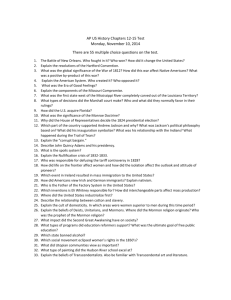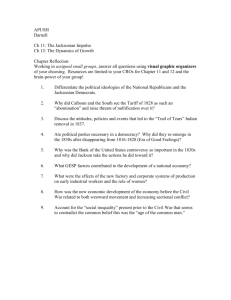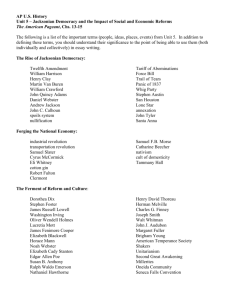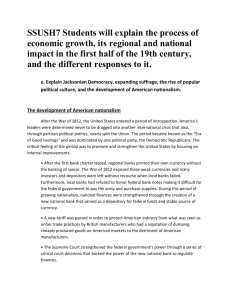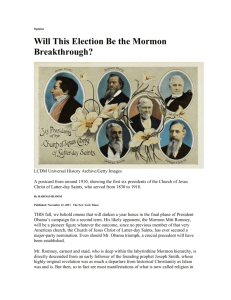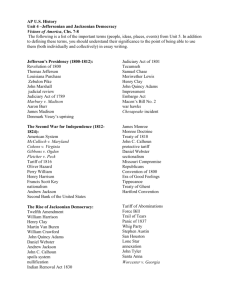The Influence of the Jacksonian Era on Mormonism 2
advertisement
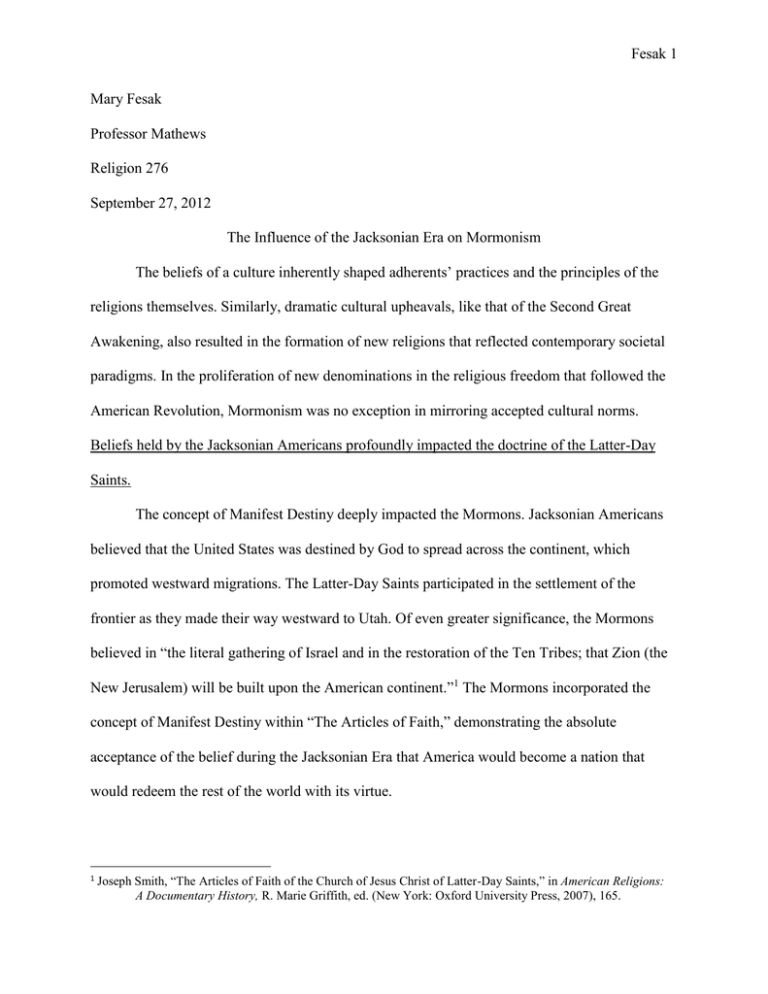
Fesak 1 Mary Fesak Professor Mathews Religion 276 September 27, 2012 The Influence of the Jacksonian Era on Mormonism The beliefs of a culture inherently shaped adherents’ practices and the principles of the religions themselves. Similarly, dramatic cultural upheavals, like that of the Second Great Awakening, also resulted in the formation of new religions that reflected contemporary societal paradigms. In the proliferation of new denominations in the religious freedom that followed the American Revolution, Mormonism was no exception in mirroring accepted cultural norms. Beliefs held by the Jacksonian Americans profoundly impacted the doctrine of the Latter-Day Saints. The concept of Manifest Destiny deeply impacted the Mormons. Jacksonian Americans believed that the United States was destined by God to spread across the continent, which promoted westward migrations. The Latter-Day Saints participated in the settlement of the frontier as they made their way westward to Utah. Of even greater significance, the Mormons believed in “the literal gathering of Israel and in the restoration of the Ten Tribes; that Zion (the New Jerusalem) will be built upon the American continent.”1 The Mormons incorporated the concept of Manifest Destiny within “The Articles of Faith,” demonstrating the absolute acceptance of the belief during the Jacksonian Era that America would become a nation that would redeem the rest of the world with its virtue. 1 Joseph Smith, “The Articles of Faith of the Church of Jesus Christ of Latter-Day Saints,” in American Religions: A Documentary History, R. Marie Griffith, ed. (New York: Oxford University Press, 2007), 165. Fesak 2 The Latter-Day Saints embraced the concept of egalitarianism as manifested in Jacksonian society. During the Jacksonian Era, equal political rights among white males became a central focus. Similarly, white male egalitarianism was visible in the Mormon priesthood. All white men could become priests, which differed from traditional hierarchically structured churches. Many contemporary religions maintained a separation between the laypeople and the members of differing religious ranks within the faith. Egalitarianism can be found within Mormon doctrines, such as the eleventh provision in “The Articles of Faith of the Church of Jesus Christ of Latter-Day Saints.” Under the eleventh provision, Mormons “claim the privilege of worshipping Almighty God according to the dictates of our own conscience, and allow all men the same privilege, let them worship how, where, or what they may.”2 In this statement, the Latter-Day Saints recognized the concepts of tolerance of religious freedom and egalitarianism prevalent in Jacksonian America. Likewise, Mormon concepts of feminism share similar principles with the Cult of Domesticity that prevailed during the Jacksonian Era. The Cult of Domesticity contended that a woman’s sphere was within the home, where she was expected to be chaste, pious, submissive to her husband, and nurturing to her children. Concepts of the Cult of Domesticity manifested themselves throughout the 1843 Revelation. In the sixty-first through the sixty-third statements in the Revelation, the virginity of the wives was highlighted as a necessary factor in polygamous marriage. Not only was chastity essential in Mormonism, women could also have only one husband, whereas men could have multiple wives. This reflected societal standards, which while considering polygamy impermissible condoned men’s extramarital affairs. Meanwhile, it was socially inacceptable for women to commit adultery. Similarly, female submissiveness was exemplified in the sixty-fourth statement which asserted that “then shall she believe and 2 Smith, “The Articles of Faith of the Church of Jesus Christ of Latter-Day Saints,” 165. Fesak 3 administer unto him, or she shall be destroyed, saith the Lord you God.”3 The religious doctrines of the Latter-Day Saints demonstrated the incorporation of female submissiveness into a religion where it served to uphold male authority and the practice of polygamy. The combination of female piety and submissiveness promoted by Jacksonian society was essential to the Revelation due to its use of religion to justify polygamy to pious and subservient women. Aspects of the Mormon Doctrine reflected the societal belief systems during the Jacksonian Era. The incorporation of the Manifest Destiny into the Mormon’s religious doctrine reflected the extent of the importance of the divine mission of the United States to expand across the continent and save the rest of the world. The ability of all white men to become priests in the Mormon Church demonstrated the increasing egalitarianism in American society, which deviated from traditional hierarchical church structures. Additionally, influences from the Cult of Domesticity served to reinforce the roles of women in Mormonism and uphold the practice of plural marriage. 3 Joseph Smith, “Revelation,” in American Religions: A Documentary History, R. Marie Griffith, ed. (New York: Oxford University Press, 2007), 171.
